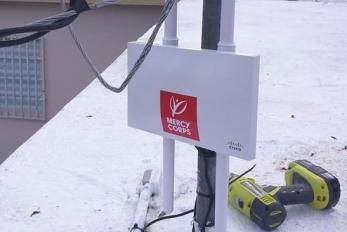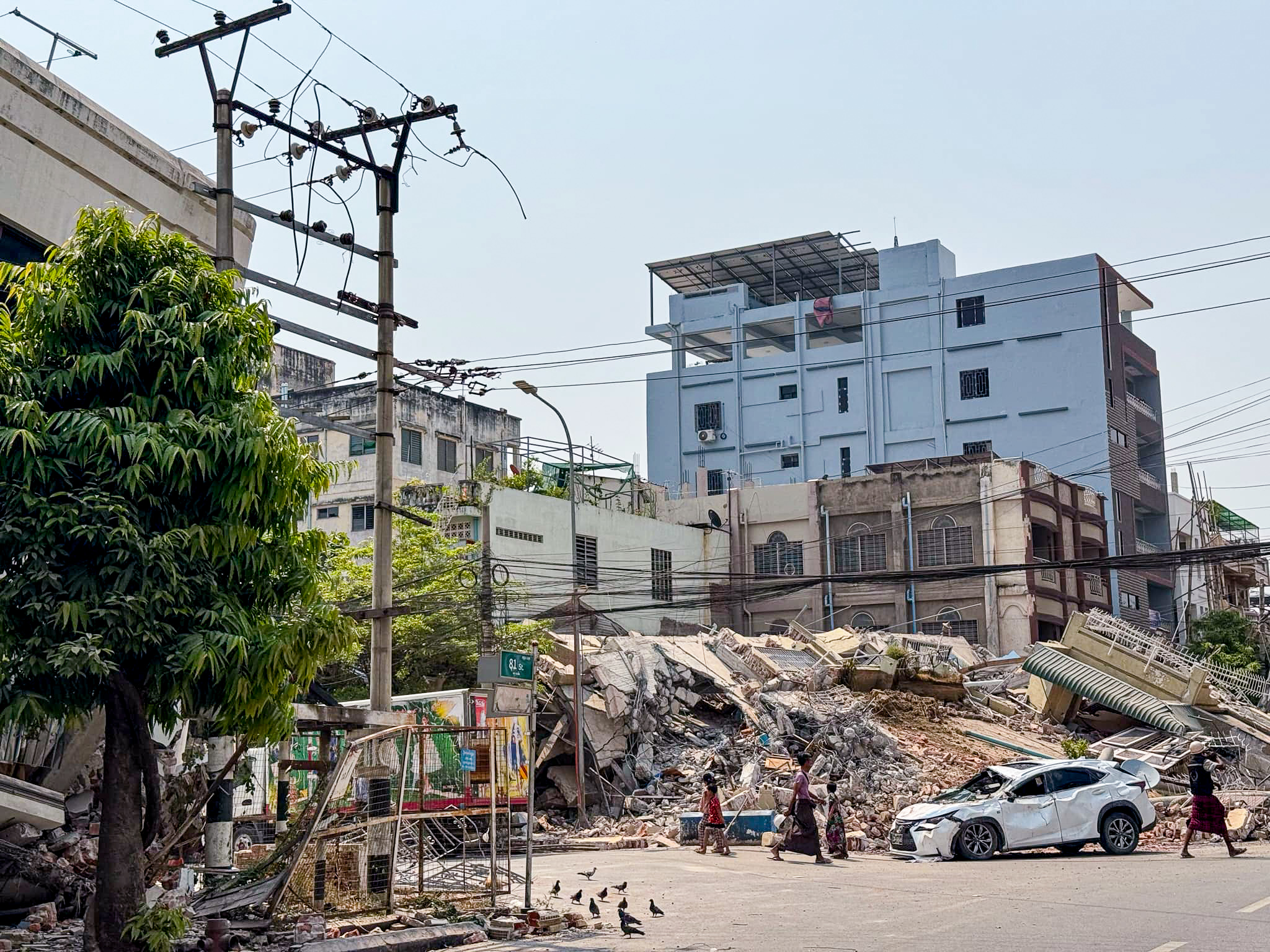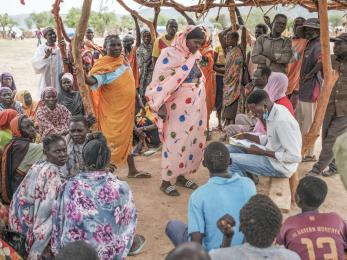Signal found: Mercy Corps & community WiFi

Imagine your home has been struck by a devastating category five hurricane. You’re left without power and connections to loved ones, news, and potentially lifesaving information. This was the reality for the survivors of Hurricane Maria after it struck Puerto Rico in September 2017. The near 100% destruction of the power grid left millions without power. No power meant no ATMs or credit card machines and and paying for goods was a challenge. A month after the storm, nearly 3 million people were still without power, a million were without tap water, and about 1.5 million did not have access to cellular services.
The loss of connectivity was devastating for those on the island as well as those trying to contact their loved ones from abroad. After Maria passed, friends and family living around the world were met with unanswered calls and without responses to their text messages, in terror over whether their loved ones survived the storm safely. On the island, the lack of connectivity was a barrier to accessing information about receiving food, clean drinking water, and other aid.
Hurricane Maria drew the largest response to a natural disaster in Puerto Rico’s history, with aid coming from several international NGOs mobilizing to the island, including Mercy Corps. Within the first few weeks, Mercy Corps’ assessments showed financial support would be one of the most impactful ways to aid the emergency relief efforts. Providing cash to people stimulated the local economy while giving families the dignity and autonomy that comes with being able to make their own choices about how they met their most critical needs. Moving beyond emergency aid, Mercy Corps’ strategy shifted to longer-term recovery and disaster resilience to strengthen communities. This strategy was marked by the launch of Mercy Corps’ Resilience Hub project.
As part of Mercy Corps’ Resilience Hub approach, the Mercy Corps Technology for Development (T4D) team deployed to Puerto Rico in the early summer of 2018 with the mission of building mechanisms for immediate communications in the event of another incident such as Hurricane Maria. Mercy Corps partnered with existing local community centers to provide the tools and support needed to transform them into Resilience Hubs, outfitted with powerful and reliable Cisco Meraki WiFi networks as well as satellite phones and backup systems for solar electricity and potable water storage.
In the months that followed, the Mercy Corps Puerto Rico team established fifteen Resilience Hubs with local partners.

The partners span from community arts centers to agricultural co-ops outfitted with Tesla solar systems, Cisco Meraki WiFi networks, and other high quality products to support electricity, communications, and potable water. These Hubs have positively impacted thousands of Puerto Ricans in their local areas and continue to provide internet connectivity to access information, news, and loved ones around the world. The networks have improved the daily operations of the partner organizations and are available, free of charge, to the community members who visit the Hubs.
The T4D team’s experience has shown that providing connectivity after a disaster, and in disaster-prone areas, is growing in importance and necessity as part of a lifesaving response. Moreover, the T4D team is eager to share its lessons learned from deploying WiFi networks in natural disaster prone environments. Drawing from the experience of supporting Mercy Corp Puerto Rico’s Resilience Hubs, T4D has learned how to better focus on: Technological Capacity, Service Provider Selection, Sustainability, and Equipment Selection in regards to deploying WiFi networks in natural disaster contexts.
Technology capacity
The wide range of technological knowledge across Mercy Corps partners was perhaps the largest challenge in regards to the roll-out of the WiFi networks deployed in the Resilience Hubs. Due to the specialized nature of skills required to deploy computer networks, T4D employed three approaches to tackle issues stemming from technological capacity: inform, collaborate, and hiring third-party service providers.
The T4D team informed the Puerto Rico team and on-site community members about WiFi networking basics in order to bolster their capacities to collaborate in designing the best network for each Hub. For example, the T4D team explained what an access point is and where it is important to install them. Furthermore, the T4D team discussed how radio strength and security parameters could be configured with community members and the Puerto Rico team. This information sharing built a base of networking capacity for the Puerto Rico team and the community partners that would be applied to designing the WiFi networks.
With these WiFi basics, the most effective network for each respective Resilience Hub was designed in collaboration between the T4D team, Mercy Corps Puerto Rico, and the partner community center. Collaborating ensured that Mercy Corps’ technical expertise could combine with each Hub’s contextual knowledge. Networks were positioned to be easily accessible to the public in case of emergencies while guarding network equipment against theft and misuse. Collaboration ensured that pre-existing Hub equipment like printers and shared drives were incorporated into the WiFi network design. Additionally, the T4D team configured traffic shaping rules to block network-abuse such as cryptocurrency mining and other high bandwidth behaviors that could prevent users from benefiting from the networks. This team effort resulted in cost-effective plans and networks that were accessible to all community members.
While collaboration and information sharing helped to alleviate technological capacity issues, at some points the T4D team was unable to be on site to support the rollout of the WiFi networks. In order to fill the gaps where T4D support was not available, third-party service providers were hired to bring additional technological capacity to the field.
Service provider selection
Mercy Corps subcontracted third-party IT service providers to fill technological knowledge gaps in the field. Mercy Corps and the service providers worked in symbiosis by clearly outlining their roles. Mercy Corps supported the service providers by managing network-needs surveys, building network maps, comparing equipment quotes, and writing scopes of work to ensure ordered equipment matched each Resilience Hub’s needs and technical requirements.
The service providers performed tasks on the ground, such as surveying locations for network suitability. These surveys inspected a potential Hub’s access to electricity, and their willingness to support free WiFi access to the local community and finance internet service provider (ISP) costs, among other key criteria. In addition to surveying for suitability, the service providers also helped to determine network needs, and install equipment in partnership with the Mercy Corps T4D team.
Sustainability
Mercy Corps set out to build up local community centers, to make them more resilient in the face of disaster. Developing stronger technical capacities for on-site network administrators meant improving the sustainability of the center’s WiFi network, communications, and overall resiliency.
Mercy Corps developed a user-friendly guide for troubleshooting as well as contact resources to help resolve WiFi network issues. The guide was translated into Spanish and shared with each Hub’s volunteer network administrators and management to be a central source of information. Moreover, Mercy Corps oriented leadership members and tech volunteers from each Resilience Hub to their network equipment and trained them on basic troubleshooting principals using their network and the guide as a curriculum.
The trainings helped each Hub to be more self-reliant on their own tech skills and to troubleshoot issues in case of emergencies. Some Hubs have reported instances where they were able to successfully identify problems and solve them because of the training they received from Mercy Corps. For example, one Hub determined an access point was not functioning properly based on its LED indicators and successfully rebooted the device to get it back online. With these skills and resources, the Resilience Hubs have become more resilient from the inside out.
In addition to technical support, Mercy Corps provided ISP assistance via financial support and counseling. Mercy Corps provided financial support to pay for internet services for the first months of internet access. After this initial assistance, Mercy Corps provided guidance on selecting the most cost-effective services for certain Resilience Hubs. In order to reinforce sustainability, all of the Resilience Hubs were eventually required to support their own ISP costs. Some of the Hubs use money earned from their community gardens to finance these costs that ultimately support the community.
Equipment selection
WiFi and networking equipment come in a wide variety of qualities from numerous manufacturers and at many different price points. When deploying networks in a post-disaster environment, equipment selection requires a context-specific evaluation of multiple issues.
Reliable equipment is essential for network deployments in austere environments. The post-disaster setting, in a location like Puerto Rico, is typically wet and hot. This means that outdoor network components like access points should be able to withstand harsh conditions, rain or shine. Heat should be a major consideration, and equipment that can withstand hot environments without a significantly climate controlled environment should be purchased.

Brand uniformity is another important factor in regards to network administration and deployment. With several major vendors producing quality cloud-based networking equipment, it’s best to stick to one product. High quality and cloud-accessible equipment from a single manufacturer will ensure the best selection of equipment for network deployments in post-disasters, and the greatest likelihood for compatibility between components. Use of a single brand approach also tends to reduce complexity and costs associated with repair and replacement. It’s worth the budget to keep all the networks under “one pane of glass” to simplify the job of the network administrators and volunteer IT supporters.
Takeaway
Deploying telecommunications equipment and planning public networks come with challenges, especially during a post-hurricane response. Mercy Corps learned effective deployments come from knowledge sharing, collaboration, choosing solid partners, and budgeting for quality equipment. Collaborating with end-users ensures networks meet the needs of their community and training local network administrators develops resilience and preparedness. Mercy Corps will keep these lessons learned on hand for future disaster response and resiliency projects. Keep an eye out in early 2020 for Mercy Corps to release research it has recently concluded in partnership with the Harvard Humanitarian Initiative regarding the relationship between access to WiFi and well-being.


